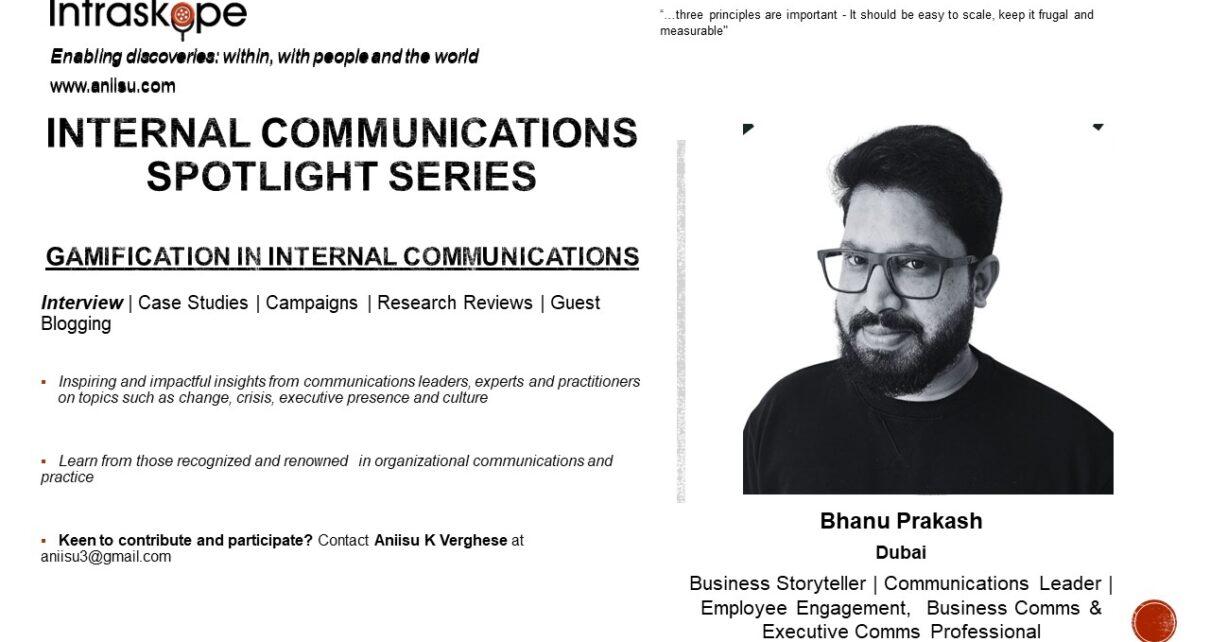Can gamification be transformational for internal communications? What will make it effective in the workplace? How can overcome barriers to gamification?
Gain insights on this topic with edition #35 of Intraskope’s Spotlight Series.
I had the pleasure of interviewing Bhanu Prakash, a seasoned communication leader who has led key initiatives, developed and executed strategies, and coached executive and senior leadership teams while serving with HSBC and most recently Amazon.
“As communication professionals, we should look beyond regular channels for cascading messages. I have personally seen very good results using gamification. This can be used especially to engage your employees when you want to drive culture. Experimenting is the key to success. Fail, but fail fast is the mantra”, says Bhanu.
In the Spotlight on Internal Communications Series, I talk to thought leaders on topics interrelated with internal communications such as culture, crisis, change, executive presence and leadership. The goal is to help unravel why they matter, what can leaders and communicators learn from experts and how we can put insights to practice.
Watch this interview with Bhanu to learn more or read the transcript of our conversation below.
Interview
- What is your understanding of gamification in internal communications?
Thanks for the interesting questions Aniisu. We at the internal communications team always try to find new and creative ways to convey our message to our audience. And we should also keep in mind that our audience is surrounded by information from various sources. So, how do we cut the clutter and make our message stand out? This is where gamification comes into play. The core objective is to have fun while playing the game and subtly push the key messages. For example, you would have played online games like Memory Game. The player needs to identify tiles with the same design/message. In the process of flipping tiles, the user reads the message multiple times, and it gets registered in their sub-cautious mind and your job is done.
2. What are the key principles?
Whenever we design and launch such games, we need to keep three principles in mind. It should be easy to scale, keep it frugal and measurable. When it comes to scalability, think of different forums/devices, and think of different languages while maintaining the same experience for the user. Everyone loves low-cost projects. So, make sure that the project does not cost much. And finally, place the right mechanisms to measure the impact. Impact in terms of participation and post-activity survey which can help show needle movement.
3. How have you applied it at work, especially in your most recent role at Amazon?
Yes. Last year, during Football World Cup, at Amazon, we launched an interesting game to convey key messages for the White Friday sale event. We developed a football penalty mobile application. The user scans the QR code, shoots a penalty, and answers a quiz question after each penalty shootout. Users can play multiple times and keep advancing to different levels in the game. At the end of the 2 weeks campaign, we recorded around 21000+ penalty shootouts and 8000+ players answered quiz questions correctly. Post-survey results were quite encouraging, more than 85% of employees understood the key messages.
4. Are there differences in the application when it comes to different cultures?
Yes, along with culture, we also need to understand our audience’s appetite. For example, let me refer to the football penalty game itself. There were a couple of strong reasons for picking this game. From a timing perspective, FIFA World Cup football was happening at the same time. Reason number two, employees in Middle East countries love Football. So, what better way to leverage this combination? So, if you are planning for the next game, please do look out for such timing and preferences of your audience. For example, IPL is quite popular, Football takes center stage in Europe, cricket in Australia, and Ruby/baseball in the United States.
5. What changes are needed internally for gamification to succeed?
Very good question Aniisu. I would use an approach instead of change. The basis on my experience, I can recommend three important approaches. Number 1: Always remember, our employees are super smart than we think, they love creative ways to be communicated. So, keep innovating on their behalf. Number 2: Like social media platforms, identify, and spread the word using influencers who can encourage participation. Do not forget to involve the leadership team. Show them having fun with the game. And number 3: Try to reach your audience via their mobile phones. We need to think beyond emails, posters, and banners. Our audience consumes information on their handheld devices around the clock.
6. What are the opportunities you see ahead for internal communicators in relation to gamification?
Times are changing Aniisu. We as Communication professionals should look beyond regular channels for cascading messages. I have personally seen very good results using gamification. This can be used especially to engage your employees when you want to drive culture. Experimenting is the key to success. Fail, but fail fast is the mantra.
7. What are the biggest obstacles?
Well, every ride cannot be a smooth ride. Here are some familiar challenges you might face. A) Getting buy-in from your senior management might be a challenge. Share data from similar campaigns from the past or from other companies, it will help build a strong proposal. B) Lack of incentivization. If the user is not getting rewarded, there might be a drop in engagement. So, reward the winners and make them celebrities. C) Lack of constant drumroll using real-time data. Games generate real-time data, so, keep making noise using this data and create more excitement throughout the campaign period.
8. Any last thoughts?
As I mentioned earlier, we as Internal Comms professionals should keep exploring new and creative ways to communicate. We should be obsessed with our employees. And think on their behalf to deliver world-class messages. Do not underestimate the power of internal communications. We are driving business, not enabling anymore.
Watch the video interview now!
Like the interview? Post your comments and share it with your network.
Keen to contribute and participate in the Spotlight series? Write to me at [email protected]
Missed the earlier episodes? Watch them here: D. Mark Schumann (Culture), Peter Yorke (Executive Presence), Sia Papageorgiou (Leadership Communications), Dianne Chase (Strategic Storytelling), Gloria Walker (Communication Planning), Rebecca Sangster-Kelly (Stakeholder Management), Ray Walsh (Localizing Employee Communications), Prof. Matt Tidwell (Reputation), Geri Rhoades (Manager Communications), Erik K Meyers (Business Acumen), Russell-Olivia Brooklands (IC Practice Governance), Paul Barton (Public Speaking and Business Communication), Cyrus Mavalwala (Digital Communication), Elvera N Makki (Social Impact Communication), Philippe Borremans (Communication Preparedness), Magdalena Petryniak (Influence in Communications), Priya Bates (Communicating Diversity & Inclusion), Zora Artis (Communication Alignment), Diana Bonczar (Communication Execution), Jane McConnell (Gig Mindset), Paul Mathews (Trust & Communications), Brad Whitworth (Creativity in Communication), Zane Ewton (Podcasting), Andrea Greenhous (Employee Experience), Jonas Bladt Hansen (Digital Technologies), Luis Suarez (Data Analytics & KM) , Laura McHale (Neuroscience in Communications),, Christopher Flores (Internal Communication Hiring) Chaya Mistry ( Human Leadership), Jenni Field (Organizational Productivity), Mike Klein (Communication Innovation), Gihan Hyde (ESG Communications), Yasser Zaki (Leadership Engagement) and Ross Monaghan (Thought Leadership).
Keen to participate in the ongoing series on Personal Branding, Crisis Communications, Internal Communications or CSR Communications? Drop me a note at [email protected]
Here are Internal Communications resources you can use:
- Learn: Internal Communications Fundamentals Course on Thinkific
- Read my latest book: Inclusive Internal Communications (2023)
- Internal Communications Series: https://forms.gle/KcqmPzLwq7NQi5Km6
- Chat with Aniisu – Internal Communications: https://www.instamojo.com/intraskope/connect-with-aniisu-60-minute-personalized-d/?ref=store
- Internal Communications workshops: https://bit.ly/2zdBRl1
You can also visit my website www.intraskope.com and You Tube channel to know more about my work.
#IC #communication #leadership #employeeengagement #engagement #internalcomms #communications #internalcommunications #covid19 #BhanuPrakash #gamification
#scale #frugality #measurement



